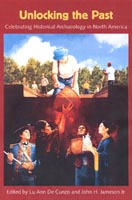Does
Historical Archaeology Really Matter in Today’s World?
Audrey Horning

"33 Repeater" toy ray gun, produced in the 1930s by the All Metal Products Company of Wyandotte, Michigan, found at the former home of Wesley and Adelaide Corbin, Corbin Hollow, Shenandoah National Park, Virginia. (Courtesy of Audrey Horning)
Like all archaeologists, I am often asked, “What’s the best
thing you’ve ever found?” And, like most, I invariably find
this question difficult to answer. For me, the genuine excitement of unearthing
an unusual or unexpected find, while intoxicating enough at the time, is
a fleeting pleasure. Besides, while an archaeologist for the Colonial Williamsburg
Foundation, I worked at sites in the restored colonial capital and at Jamestown
and Martin’s Hundred where most newly uncovered objects pale into
insignificance given the enormity of the existing archaeological collections,
amassed through the work of pioneering historical archaeologists Ivor Noel-Hume,
J.C. Harrington, and John Cotter. What lingers in my mind are the human
stories that emerge from the totality of field, laboratory, and historical
research, and the way those stories resonate today.
Fundamentally, the study of material culture from any time or place, whether
buried in an archaeological site, preserved in an old trunk, or revered
as a glass-encased objet d’art, is about the people who interacted
with those objects--the producers, the consumers, the discarders, the hoarders,
the admirers--all of whom consciously or unconsciously attach meaning to
material. How we tease out these disparate meanings from seemingly mute
objects in our efforts to interpret and understand the past is the true
challenge of archaeology--regardless of the intrinsic “neatness”
or monetary worth of any individual excavated object. Having said that,
I deeply respect the power of a single artifact to silently yet powerfully
convey an important message.
So then, what is the best artifact I’ve ever found? A rusted, fragmentary toy ray gun, uncovered with a colleague, Elizabeth Jordan, in the rubble of an abandoned log house high up on a forested mountain slope in Virginia’s Shenandoah National Park. What is so special about this ray gun, tangible proof of the rocketing popularity of the youthful and heroic Buck Rogers during the Depression era? It’s not so much the surviving details of its futurist styling; nor the way it comfortably fits into the palm of my hand; nor even the fact that I can document its manufacture in Wyandotte, Michigan between 1934 and 1941 (hardly an ancient treasure!). What is significant about this compelling artifact is where it was found and what greater meaning it holds for the past and, more importantly, for the present.
Let me explain . . .
About the Author:
Audrey J. Horning is Assistant Professor of Anthropology at the College of William and Mary and Director of the Achill Archaeological Field School in the Republic of Ireland.
